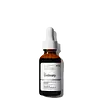What's inside
What's inside
 Key Ingredients
Key Ingredients

 Benefits
Benefits

 Concerns
Concerns

 Ingredients Side-by-side
Ingredients Side-by-side

Water
Skin ConditioningGlycerin
HumectantCaprylic/Capric Triglyceride
MaskingEthyl Linoleate
EmollientPropanediol
SolventDimethyl Isosorbide
SolventCetearyl Isononanoate
EmollientBisabolol
MaskingHydroxypinacolone Retinoate
Skin ConditioningRetinol
Skin ConditioningTasmannia Lanceolata Fruit/Leaf Extract
AntioxidantInulin Lauryl Carbamate
Emulsion StabilisingGlyceryl Stearate
EmollientCeteareth-12
EmulsifyingCeteareth-20
CleansingCetearyl Alcohol
EmollientCarrageenan
Xanthan Gum
EmulsifyingAcacia Senegal Gum
MaskingCetyl Palmitate
EmollientSucrose Laurate
EmollientPolysorbate 20
EmulsifyingIsoceteth-20
EmulsifyingRosmarinus Officinalis Leaf Extract
AntimicrobialHydroxymethoxyphenyl Decanone
Skin ConditioningBehentrimonium Chloride
PreservativeTrisodium Ethylenediamine Disuccinate
Disodium EDTA
Dehydroacetic Acid
PreservativeBenzoic Acid
MaskingEthylhexylglycerin
Skin ConditioningPhenoxyethanol
PreservativeChlorphenesin
AntimicrobialWater, Glycerin, Caprylic/Capric Triglyceride, Ethyl Linoleate, Propanediol, Dimethyl Isosorbide, Cetearyl Isononanoate, Bisabolol, Hydroxypinacolone Retinoate, Retinol, Tasmannia Lanceolata Fruit/Leaf Extract, Inulin Lauryl Carbamate, Glyceryl Stearate, Ceteareth-12, Ceteareth-20, Cetearyl Alcohol, Carrageenan, Xanthan Gum, Acacia Senegal Gum, Cetyl Palmitate, Sucrose Laurate, Polysorbate 20, Isoceteth-20, Rosmarinus Officinalis Leaf Extract, Hydroxymethoxyphenyl Decanone, Behentrimonium Chloride, Trisodium Ethylenediamine Disuccinate, Disodium EDTA, Dehydroacetic Acid, Benzoic Acid, Ethylhexylglycerin, Phenoxyethanol, Chlorphenesin
Snail Secretion Filtrate
Skin ConditioningGlycerin
HumectantCetyl Ethylhexanoate
EmollientDipropylene Glycol
HumectantDiisostearyl Malate
EmollientNiacinamide
SmoothingCetearyl Alcohol
EmollientChondrus Crispus Extract
Skin ConditioningSaccharum Officinarum Extract
MoisturisingHydrogenated Olive Oil
Skin Conditioning1,2-Hexanediol
Skin ConditioningButyrospermum Parkii Butter
Skin ConditioningPolysorbate 60
EmulsifyingBeeswax
Emulsion StabilisingAdenosine
Skin ConditioningAmmonium Acryloyldimethyltaurate/Vp Copolymer
Water
Skin ConditioningCaprylyl Glycol
EmollientCarbomer
Emulsion StabilisingCassia Angustifolia Seed Polysaccharide
Skin ConditioningCeramide NP
Skin ConditioningCitric Acid
BufferingDextrin
AbsorbentDimethicone
EmollientDisodium EDTA
Glyceryl Stearate
EmollientHydroxyethylcellulose
Emulsion StabilisingMadecassoside
AntioxidantOlea Europaea Fruit Oil
MaskingOlea Europaea Oil Unsaponifiables
Skin ConditioningPanthenol
Skin ConditioningParfum
MaskingPEG-100 Stearate
Sodium Hyaluronate
HumectantSodium Polyacrylate
AbsorbentSorbitan Sesquioleate
EmulsifyingStearic Acid
CleansingTheobroma Cacao Extract
Skin ConditioningTromethamine
BufferingPhenoxyethanol
PreservativeCitronellol
PerfumingLinalool
PerfumingCaramel
Cosmetic ColorantSnail Secretion Filtrate, Glycerin, Cetyl Ethylhexanoate, Dipropylene Glycol, Diisostearyl Malate, Niacinamide, Cetearyl Alcohol, Chondrus Crispus Extract, Saccharum Officinarum Extract, Hydrogenated Olive Oil, 1,2-Hexanediol, Butyrospermum Parkii Butter, Polysorbate 60, Beeswax, Adenosine, Ammonium Acryloyldimethyltaurate/Vp Copolymer, Water, Caprylyl Glycol, Carbomer, Cassia Angustifolia Seed Polysaccharide, Ceramide NP, Citric Acid, Dextrin, Dimethicone, Disodium EDTA, Glyceryl Stearate, Hydroxyethylcellulose, Madecassoside, Olea Europaea Fruit Oil, Olea Europaea Oil Unsaponifiables, Panthenol, Parfum, PEG-100 Stearate, Sodium Hyaluronate, Sodium Polyacrylate, Sorbitan Sesquioleate, Stearic Acid, Theobroma Cacao Extract, Tromethamine, Phenoxyethanol, Citronellol, Linalool, Caramel
 Reviews
Reviews

Ingredients Explained
These ingredients are found in both products.
Ingredients higher up in an ingredient list are typically present in a larger amount.
Cetearyl alcohol is a mixture of two fatty alcohols: cetyl alcohol and stearyl alcohol. It is mainly used as an emulsifier. Emulsifiers help prevent the separation of oils and products. Due to its composition, it can also be used to thicken a product or help create foam.
Cetearyl alcohol is an emollient. Emollients help soothe and hydrate the skin by trapping moisture.
Studies show Cetearyl alcohol is non-toxic and non-irritating. The FDA allows products labeled "alcohol-free" to have fatty alcohols.
This ingredient is usually derived from plant oils such as palm, vegetable, or coconut oils. There is debate on whether this ingredient will cause acne.
Due to the fatty acid base, this ingredient may not be Malassezia folliculitis safe.
Learn more about Cetearyl AlcoholDisodium EDTA plays a role in making products more stable by aiding other preservatives.
It is a chelating agent, meaning it neutralizes metal ions that may be found in a product.
Disodium EDTA is a salt of edetic acid and is found to be safe in cosmetic ingredients.
Learn more about Disodium EDTAGlycerin is already naturally found in your skin. It helps moisturize and protect your skin.
A study from 2016 found glycerin to be more effective as a humectant than AHAs and hyaluronic acid.
As a humectant, it helps the skin stay hydrated by pulling moisture to your skin. The low molecular weight of glycerin allows it to pull moisture into the deeper layers of your skin.
Hydrated skin improves your skin barrier; Your skin barrier helps protect against irritants and bacteria.
Glycerin has also been found to have antimicrobial and antiviral properties. Due to these properties, glycerin is often used in wound and burn treatments.
In cosmetics, glycerin is usually derived from plants such as soybean or palm. However, it can also be sourced from animals, such as tallow or animal fat.
This ingredient is organic, colorless, odorless, and non-toxic.
Glycerin is the name for this ingredient in American English. British English uses Glycerol/Glycerine.
Learn more about GlycerinGlyceryl Stearate is a mix of glycerin and stearic acid.
It is used to stabilize the mixing of water and oil ingredients. By preventing these ingredients from separating, it can help elongate shelf life. It can also help thicken the product's texture.
As an emollient, it helps soften skin and supports barrier-replenishing ingredients.
In cosmetics, Glyceryl Stearate is often made from vegetable oils or synthetically produced.
This ingredient may not be fungal-acne safe
Fun fact: The human body also creates Glyceryl Stearate naturally.
Learn more about Glyceryl StearatePhenoxyethanol is a preservative that has germicide, antimicrobial, and aromatic properties. Studies show that phenoxyethanol can prevent microbial growth. By itself, it has a scent that is similar to that of a rose.
It's often used in formulations along with Caprylyl Glycol to preserve the shelf life of products.
Water. It's the most common cosmetic ingredient of all. You'll usually see it at the top of ingredient lists, meaning that it makes up the largest part of the product.
So why is it so popular? Water most often acts as a solvent - this means that it helps dissolve other ingredients into the formulation.
You'll also recognize water as that liquid we all need to stay alive. If you see this, drink a glass of water. Stay hydrated!
Learn more about Water